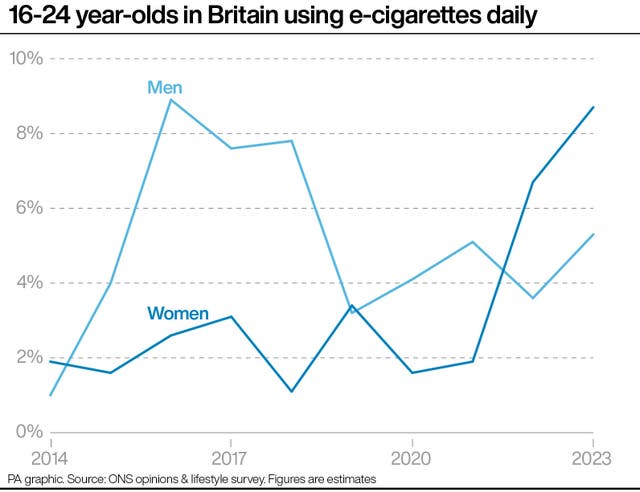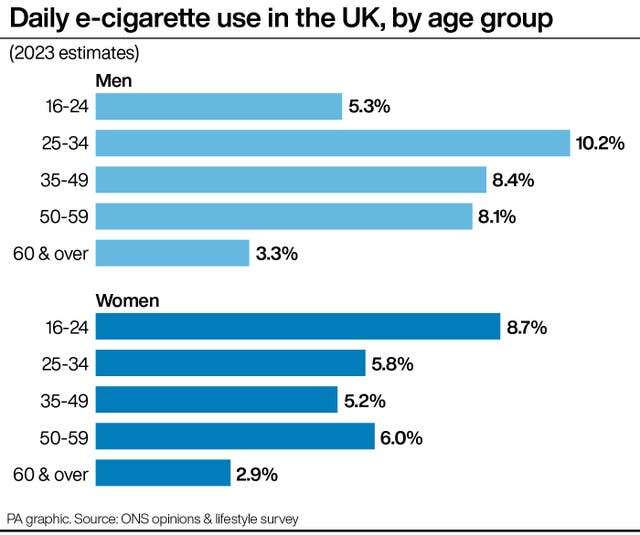Proportion of women aged 16-24 vaping daily highest since current records began
It also emerged that around 5.1 million people aged 16 or over are likely to have vaped every day or occasionally in 2023.

The proportion of women aged 16 to 24 in Great Britain who are daily e-cigarette users is at its highest level since current records began, new figures suggest.
Some 8.7% of females in this age group are likely to have used vapes every day last year, up from 6.7% in 2022 and 1.9% in 2021.
Some 5.3% of men aged 16-24 vaped daily in 2023, up from 3.6% in 2022 but below levels seen before the Covid-19 pandemic.

They show that around 9.8% of people aged 16 or over – or 5.1 million – are likely to have vaped every day or occasionally in 2023.
E-cigarette use “continued to increase most substantially” among people aged 25 to 34 during the period, the ONS said.
The percentage of men aged 25 to 34 who used e-cigarettes daily was 10.2% in 2023, up from 7.4% in 2022 but lower than the 11.3% reported in 2021.

Professor Nick Hopkinson, respiratory physician and chairman of public health charity Action on Smoking and Health (Ash), said: “Vaping has helped millions of adults quit smoking and is much less harmful than smoking.
“However, it is not risk-free and high levels of use among young people and growing use among never smokers is a concern.”
Publication of the figures comes after the Government revived plans to introduce the Tobacco and Vapes Bill in July.
The law change could progressively increase the age at which people can buy tobacco, preventing anyone born after January 1 2009 being legally able to do so.
It could also lead to restrictions on the flavours, packaging and display of vapes.
Prof Hopkinson added: “The Government must get its Tobacco and Vapes Bill into law as soon as possible, to provide a tough regulatory framework to control the marketing and sale of e-cigarettes.
“We need to reinforce the role of vaping as a tool to stop smoking, not a lifestyle accessory.”
Elsewhere, the ONS’s Annual Population Survey (APS) estimates around 11.9% of people aged 18 or over – the equivalent of around six million – smoked cigarettes in the UK in 2023.
It is the lowest proportion of current smokers since ONS records began in 2011.
The percentage of current smokers is 11.6% in England, 12.6% in Wales, 13.3% in Northern Ireland and 13.5% in Scotland.
The age group with the highest proportion of current smokers is 25 to 34 with 14%.
Those aged 18 to 24 reported the largest drop in smoking, falling from 15.9% in 2011 to 9.8% in 2023.
Men are more likely to smoke than women, with about 3.4 million males reported as smokers in 2023 compared with 2.6 million females.
Unemployed people also have a higher proportion of current smokers at 19.7%, the ONS said, compared with those in paid work (11.4%).
Of those who reported having no qualifications, 27.4% were smokers in 2023.
This compared with people listed as having “other qualifications” (21.8%), those who reported GCSEs as their highest level of education (18%) and those who reported a degree or equivalent as their highest level of education (5.8%).
Ash chief executive Hazel Cheeseman said: “Today’s figures are further proof that the country is ready to be smoke-free.

“Despite the progress there is still much to be done. Our poorest communities continue to pay the price for tobacco company profits, as do our public services and economy.
“Alongside creating a smoke-free generation, the Government must maintain the commitment of the last government to invest in support to help the six million people currently smoking to quit.”
A Department of Health and Social Care spokesperson said: “Vapes can be an effective way for adult smokers to quit, but we have always been clear children and adult non-smokers should not vape.
“Meanwhile, smoking claims 80,000 lives a year, puts huge pressure on our NHS, and costs taxpayers billions.
“The Tobacco and Vapes Bill will protect future generations from the harms of tobacco and nicotine, saving thousands of lives and easing pressures on the NHS.
“By building a healthier society, we will help to build a healthy economy.”





